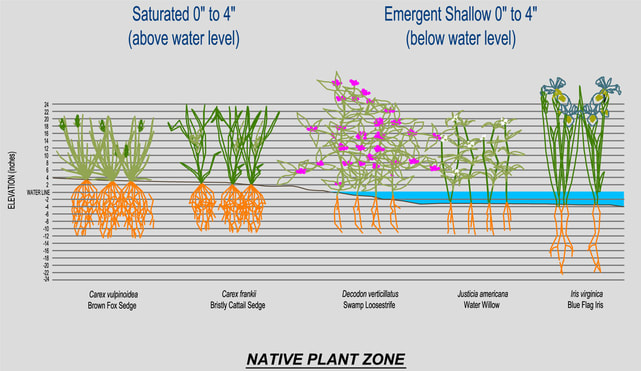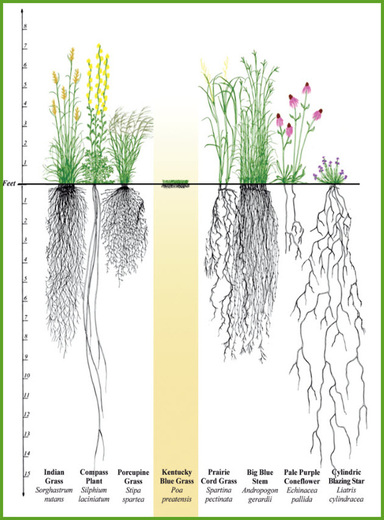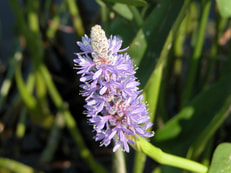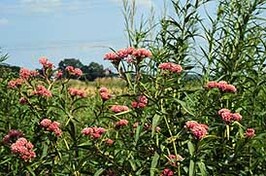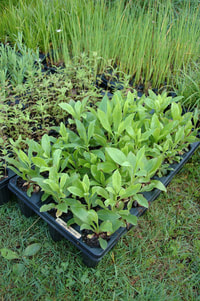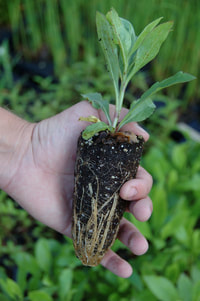Why Native Plants? Plants are a critical component of a natural shoreline.
|
Michigan native plants:
|
"Note: The Michigan Department of Environment Great Lakes and Energy's bioengineering permit does require the use of Michigan native plants below the ordinary high water mark. |
While many non-native plants used in a homeowners' landscape are not harmful, some, called invasive non-native, become serious problems. These plants easily spread to native habitats and displace native species because they have competitive advantages and no natural biological controls to keep them in check. Invasive non-native plants provide little benefit to wildlife because native animals are adapted to use native plants, not the foreign invaders.
Native plant root structure:
The plants that naturally occur at your lakeshore have the root structure that is adapted to being at the lakeshore. These plants have a fairly dense and strong interwoven system that are "designed" to stand up against waves and hold the soil in place. These are referred to as "Workhorse Species".
The graphics below illustrate the root depth of some native plants that are found along Michigan's inland lakes. As you can see some of the root systems go as deep as 1 foot and some even deeper. The root depth of turf grass varies as well but generally turfgrass is very shallow and not adapted to be along shorelines thus it cannot hold the soil in place against wave action very well at all. The graphic on the right illustrates Kentucky Blue grass root depth compared to other native plants (note: most of the plants in the graphic on the right would not necessarily naturally be found at the lake edge. This is shown for illustration purposes.)
The plants that naturally occur at your lakeshore have the root structure that is adapted to being at the lakeshore. These plants have a fairly dense and strong interwoven system that are "designed" to stand up against waves and hold the soil in place. These are referred to as "Workhorse Species".
The graphics below illustrate the root depth of some native plants that are found along Michigan's inland lakes. As you can see some of the root systems go as deep as 1 foot and some even deeper. The root depth of turf grass varies as well but generally turfgrass is very shallow and not adapted to be along shorelines thus it cannot hold the soil in place against wave action very well at all. The graphic on the right illustrates Kentucky Blue grass root depth compared to other native plants (note: most of the plants in the graphic on the right would not necessarily naturally be found at the lake edge. This is shown for illustration purposes.)
MNSP Recommended Plant List
Don't know what plants you should plant where? The MNSP has helped to make these decisions easier by creating a plant list. The plants are organized into the different areas of the shoreline where they are the most successful and do "the work" they were designed to do the best.
Plant List Criteria:
Although, there are many more plants native to Michigan the plants on this list were chosen because they are:
1) Native to Michigan
2) Not listed as threatened or endangered.
3) Generally broadly adapted - meaning that they are not extremely fussy as to where they grow.
4) Broadly distributed naturally around the state
5) Currently on the market or could easily be brought into the market.
Don't know what plants you should plant where? The MNSP has helped to make these decisions easier by creating a plant list. The plants are organized into the different areas of the shoreline where they are the most successful and do "the work" they were designed to do the best.
Plant List Criteria:
Although, there are many more plants native to Michigan the plants on this list were chosen because they are:
1) Native to Michigan
2) Not listed as threatened or endangered.
3) Generally broadly adapted - meaning that they are not extremely fussy as to where they grow.
4) Broadly distributed naturally around the state
5) Currently on the market or could easily be brought into the market.
Four Different Zones:
The plants have been placed in each category based on their suitability for the water levels and other variables such as wave action. However, once these plants have been planted they may “move” into a different area. This is because natural conditions at each particular site are highly variable, and each plant will find specific areas most suitable for their growth.
Additionally, information on the amount of light, plant height, bloom time and color, special adaptive features and the tolerance level to siltation. Siltation refers to soil particles building up in a particular area. This puts stress on plants often resulting in reduced growth or reproduction. A “high” on the plant matrix indicates that a particular plant has a high level of tolerance to siltation.
The plants have been placed in each category based on their suitability for the water levels and other variables such as wave action. However, once these plants have been planted they may “move” into a different area. This is because natural conditions at each particular site are highly variable, and each plant will find specific areas most suitable for their growth.
- “Below the Water Level”:
- These are the plants that are found in the aquatic zone. Use these plants for planting areas within the lake.
- “Between the Water Level and the Ordinary High Water Mark”:
- These plants like it wet but do not like to actually be in the lake. They can handle frequent water level changes ranging from being flooded for days at a time to being dry for short periods of time. These plants are also the best ones to withstand the energy from wave action and ice push.
- “Above the Ordinary High Water Mark”:
- These plants are still considered wetland plants but they are typically further from the lake edge. They like the soil to be consistently moist and they can handle a small amount of flooding. They do not like the constant stress that comes from waves and ice.
- “Upland Plants”:
- These plants like dry conditions. This section was included to provide homeowners with native plant suggestions to use in the remaining part of the landscape to allow for opportunities for a comprehensive landscape design.
Additionally, information on the amount of light, plant height, bloom time and color, special adaptive features and the tolerance level to siltation. Siltation refers to soil particles building up in a particular area. This puts stress on plants often resulting in reduced growth or reproduction. A “high” on the plant matrix indicates that a particular plant has a high level of tolerance to siltation.
|
There are a variety of options for plant stock but generally they come in 38 cell plug flats. Planting recommendations should be based on species however, generally 1 plug per square foot. Example: 100 square foot of a planting area = 100 plants Remember to include rushes, sedges and grasses to provide strong root structure. Trees and shrubs are incredible important as well! |
Where can I find Michigan Native Plants?
Finding sources of native plants can be a bit challenging but they do exist! There are many local greenhouses that are beginning to carry native plants.
However, be aware that many times the plants may not have come from MI native plant stock and/or they may be cultivars of a specific plant.
|
Are you a Greenhouse growing Michigan Native Plants?
To be listed on this site as a grower or supplier: 1) must be growing or supplying Michigan native plants that are not specifically "cultivars" or "nativars" of a species or sourced from another region. *A nursery does not have to solely be growing all Michigan natives. Note: There are some species that a Michigan genotype no longer exists and where that is applicable growers typically indicate it. 2) Have information on a website or social media page about the Michigan native plants being grown/available. Contact: Julia Kirkwood [email protected] 269-312-2760 |
In addition, to these Native Plant Nurseries pay attention to your local Conservation District and Nature Centers for annual native plant sales.
|
Native Plant Organizations
Wildflower Association of Michigan
The Wildflower Association of Michigan encourages the preservation and restoration of Michigan's native plants and native plant communities. They list sources of native plants and have a business directory on their website. Some grow plant stock and others provide seed. They typically have catalogs online.
Wild Ones
Wild Ones: Native Plants, Natural Landscapes promotes environmentally sound landscaping practices to preserve biodiversity through the preservation, restoration and establishment of native plant communities. Find a Local Chapter.
Native Plant Guild
The Native Plant Guild is an alliance of local businesses and organizations that offers West Michigan a variety of ecological landscaping services.
From planning, design, installation and maintenance to providing Michigan native seed and plants, these professionals work together to promote stewardship of our land and waters as they establish, restore, and preserve natural landscapes.
Plant it Wild
The mission of PLANT IT WILD is to foster greater awareness and appreciation of the fragile natural environment of our region. Through direct efforts they work to preserve, protect, and promote the natural beauty of the area and its plant communities. Offering Programs and Field Trips May through September that feature a wide array of speakers and topics on native plants. This group promotes the use of native plant species by producing educational materials available at meetings, booths, presentations, and their website.
The Wildflower Association of Michigan encourages the preservation and restoration of Michigan's native plants and native plant communities. They list sources of native plants and have a business directory on their website. Some grow plant stock and others provide seed. They typically have catalogs online.
Wild Ones
Wild Ones: Native Plants, Natural Landscapes promotes environmentally sound landscaping practices to preserve biodiversity through the preservation, restoration and establishment of native plant communities. Find a Local Chapter.
Native Plant Guild
The Native Plant Guild is an alliance of local businesses and organizations that offers West Michigan a variety of ecological landscaping services.
From planning, design, installation and maintenance to providing Michigan native seed and plants, these professionals work together to promote stewardship of our land and waters as they establish, restore, and preserve natural landscapes.
Plant it Wild
The mission of PLANT IT WILD is to foster greater awareness and appreciation of the fragile natural environment of our region. Through direct efforts they work to preserve, protect, and promote the natural beauty of the area and its plant communities. Offering Programs and Field Trips May through September that feature a wide array of speakers and topics on native plants. This group promotes the use of native plant species by producing educational materials available at meetings, booths, presentations, and their website.

